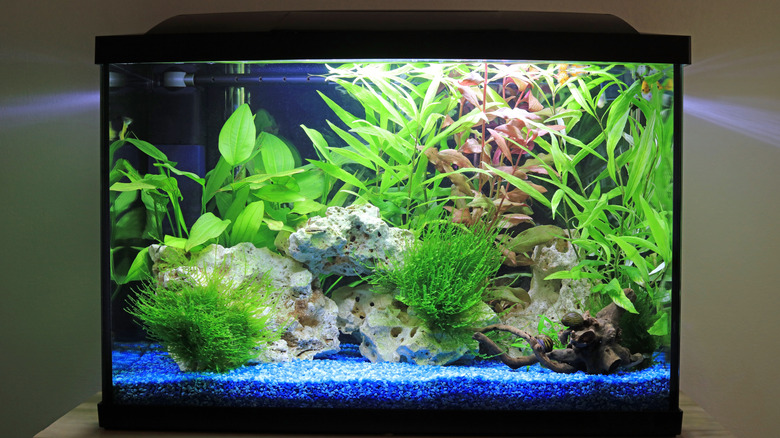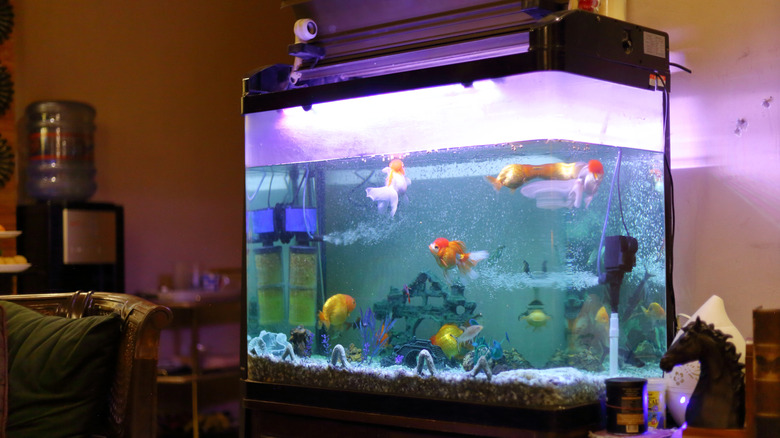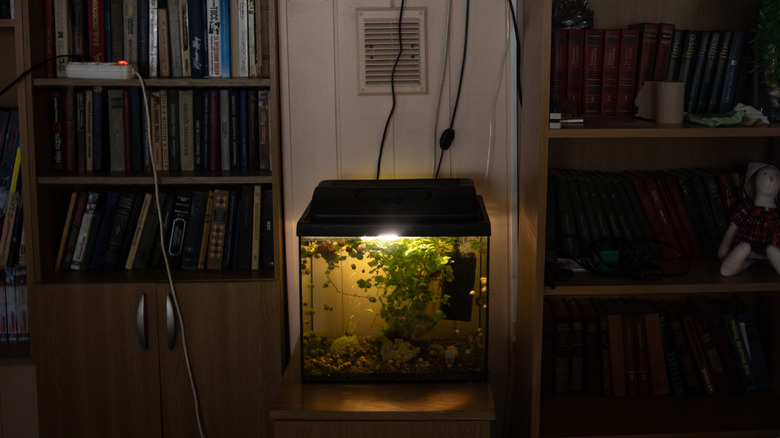Here's What To Do If Your Fish Tank Cracks
We may receive a commission on purchases made from links.
Nearly 64 million American households owned pets in 2021, according to the U.S. Census Bureau. That's around 50% of all occupied housing units, and among them, five million houses reported owning fish. Keeping small pets is a great way to learn about caring for and nurturing other living beings, they provide a constant source of companionship, and there are health benefits to watching fish in their tanks: improving mood, as well as reduced stress, anxiety, and blood pressure. Public aquariums are also shown to facilitate greater social interactions on top of their role in education and wildlife conservation. However, keeping fish at home is more precarious than some animals, especially if your fish tank begins to crack.
Unlike other household staple pets — dogs, cats, or birds — fish are wholly reliant on whatever pocket of water you provide. This involves spinning dozens of plates with regards to setting up your tank's environmental parameters, as almost every species of fish requires different microclimate temperature, pH levels, and sunlight exposure, not to mention cleaning algae and waste off the tank and water filter systems. It's generally not recommended to remove your fish from its tank given changes in environment can be especially stressful, but be prepared for this possibility if you need to really dig into some fixes for your cracked fish tank, whether it be patching the glass or replacing an entire pane.
Patching the glass on a cracked fish tank
Even if your fish tank is showing signs of minor damage or a small hairline cracked glass pane that appears momentarily stable, you may want to temporarily remove your fish. However, in this case you can just patch the glass before it succumbs to internal pressure. This is an inexpensive method, but one that should only be considered a temporary fix. The patch job is just a Band-Aid over the issue, and one that will be plainly visible.
Once the tank is drained, start the process by gently blowing a stream of air into the crack, removing any dust, dirt, or glass particles. Then, flush it clean by applying solvents using a syringe or eyedropper: methyl ethyl ketone (also known as butanone) or acetone are recommended. Fill the crack with American Sealants aquarium silicone, and use Scotch tape on the outside to help secure it. Use the silicone to coat one side of your patching glass, and then press that onto the interior wall of the aquarium; the patch should be wide enough to offer a few extra inches of protection around the crack.
Once it dries, you can remove the Scotch tape (and its residue), and then scrape away excess silicone using a scalpel. Make sure to test your patch job a few times by filling and draining the tank before returning your fish. It would be a shame to do all of this work and then find out the seal isn't perfect.
When a crack in your fish tank requires a total replacement
If the cracks in your fish tank are leaking water, it may be worth just replacing that cracked pane. Those cracks will grow over time and weaken the glass as water molecules get inside and speed up its degradation, so it would be best to avoid a situation where you find your floor covered in glass, water, and flopping fish.
A full pane replacement can be cheaper than buying a whole new fish tank, but only if the process goes smoothly. If the tank uses a black plastic trim, this will have to be removed. If you don't need to reattach the trim later for structural integrity, you can weaken its silicone seal with vinegar or heat and then split the rubber into pieces with a box cutter. After that, clear away silicone from between glass panes so you can remove the cracked face, and then make sure the replacement doesn't move as you apply and set new aquarium silicone on the inside and outside edges. Consider using an acrylic plastic like lucite that's more crack resistant than glass.
This is a long, difficult process that could leave you with new problems if the seals aren't perfect and begin leaking. At the end of the day it may be worth calling a professional, or buying something new and converting the cracked tank into a terrarium. Either option is better than releasing your fish into the wild, which can cause undue stress, leave the fish susceptible to predators, or add an invasive species to local ecosystems.


